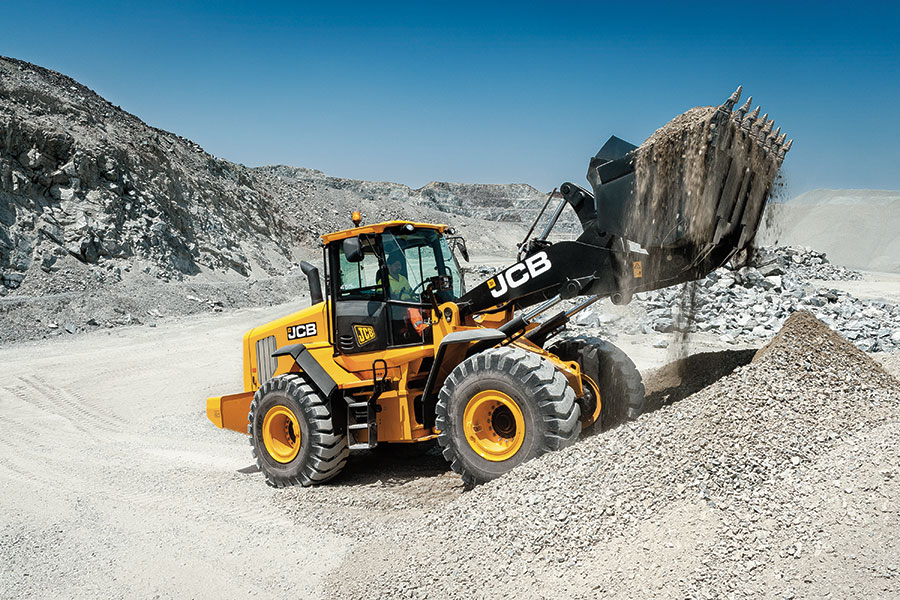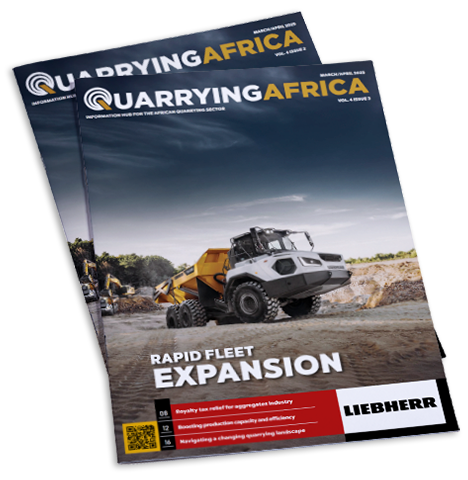Wheel loaders are considered essential pieces of equipment for many quarry operators as they fulfil various important functions, perhaps the most common being stockpiling material and loading haul vehicles. They are also the ideal machine to feed crushers with material and for housekeeping under conveyor belts and around the worksite in general, says Petrie du Toit, sales product manager at Bell Equipment.
“It is important for quarry operators to choose the right machine to promote efficiency in the quarry. It should be a reliable workhorse that offers the lowest cost per tonne solution. It needs to be able to comfortably handle the production targets and other tasks it will be used for,” says Du Toit. “If the wheel loader is too small, its work pressures could cause undue stress that could negatively affect the machine’s longevity. At the same time, a machine that is too large will not be economical to run.”
Warren Alexander, branch manager, Isando, at CASE Construction Equipment SA, shares the same view, pointing out that a wheel loader plays a vital role in quarry operations due to its versatility and efficiency in handling a wide range of tasks. It serves as a reliable workhorse for material handling, such as loading and transporting various types of aggregate, gravel and other materials.
“The right wheel loader can significantly enhance productivity, reduce downtime and optimise overall quarry operations. Choosing the right machine is crucial as it ensures optimal performance, durability and cost-effectiveness, leading to improved operational efficiency and profitability for quarry operators,” says Alexander.
Gary Martin, senior market professional for heavy construction and quarry industries, Caterpillar, says quarries are large areas with typically two or more different faces being worked at any given time. Unlike the excavator, the wheel loader has the mobility to move easily from face to face to load the trucks and requires no clean-up machine to follow it.
“The fragmentation of the material needs to be correct for the wheel loader to be productive, and in these conditions it is unbeatable. For the midsized wheel loaders, mobility is key when working around the screening plants in operations such as load and carry, as well as for carrying the material from the conveyor stockpile to the main stockpile,” says Martin.
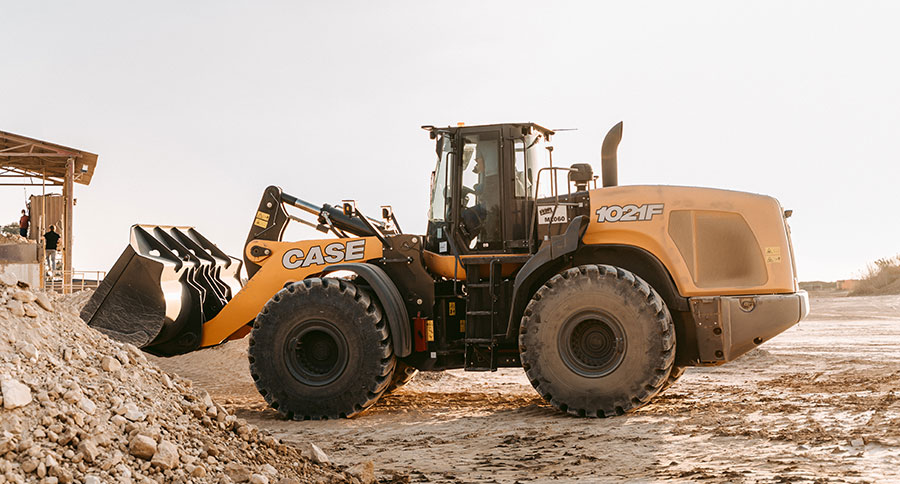
Key factors
Given the importance of the wheel loader on a quarry site, what are some of the key factors to consider when choosing the right machine for one’s operations?
CASE’s Alexander says that the machine’s size and bucket capacity should match the specific requirements of the quarry site, considering the volume and weight of materials to be handled.
Power and performance, adds Alexander, are also crucial parameters to consider. “Evaluate the engine power, hydraulic system efficiency and lifting capabilities to ensure the wheel loader can handle the demanding tasks efficiently,” he says.
Durability and reliability are also non-negotiables, says Alexander. Quarry environments are rugged, so it is important to choose a wheel loader built with robust construction and high-quality components that can withstand the harsh conditions.
Given the high local fuel prices, fuel efficiency is an important factor. Quarry operators, says Alexander, should therefore choose machines that offer optimum fuel efficiency to minimise operating costs and reduce their environmental impact.
The correct wheel loader for an operation should also tick the operator comfort and safety box. This should consider features such as an ergonomic cab design, intuitive controls and advanced safety systems to enhance operator comfort, productivity and overall site safety.
“After-sales support is crucial for maintaining the optimal performance and uptime of the wheel loader. It is important to partner with a construction equipment company that offers comprehensive after-sales support. This includes timely maintenance, spare parts availability, technical assistance and training programmes. It also provides peace of mind knowing that the company is committed to supporting the customer throughout the lifecycle of the equipment,” says Alexander.
According to Martin, one of main factors when selecting the right loader for either working at the face or at the processing plant, is ensuring that it meets the expected production targets. That has a direct impact on correctly sizing the loader.
“Bench height and bench width play a key role in any face loading machine selection,” says Martin. “If the face is too high, then it becomes too dangerous to work under the face with a wheel loader, and an alternative loading tool will have to be selected. For safety, the face height should not exceed the maximum lift height of the wheel loader bucket. The wheel loader needs room to manoeuvre when loading the truck, so bench width and an open area are very important for a productive wheel loader operation.”
Du Toit maintains that productivity or tonnes per hour required from the machine is a key factor. Other factors include the underfoot conditions that the machine will operate in and the SG (specific gravity) of the material/s to be loaded or stockpiled.
“The underfoot conditions will impact the tyre and axle choice, for example, diff lock or limited slip. Typically, wheel loaders are fitted with L3 or L5 radial tyres in quarrying applications. The SG will determine the type of bucket the machine should be fitted with. Safety features that protect the operator and the machine, as well as operator comfort are other important considerations since a comfortable operator is a productive one,” says Du Toit.
While most machines in the market have very similar attributes, adds Du Toit, the most important factor to keep the quarry running is the support network. Having a support centre close to the quarry with fully trained technical experts and parts stock to ensure quick turnaround is crucial.
“Bell prides itself on offering sound support to our customers through continuous training of new and old technicians and by holding high levels of parts stock both at branches around the country and at our Global Logistics Centre that can deliver within 24 hours, to anywhere in the country. Currently, Bell holds over R110-million worth of JCB spare parts, including new, used and reman parts,” he says.

Key benefits
The benefits of choosing the right machine for the right application abound. Caterpillar’s Martin says the right machine ensures high production in a truck loading application and a low cost per tonne moved, with no supporting machine needed.
CASE’s Alexander tells Quarrying Africa that the benefits of choosing the right wheel loader for quarry operations are manifold. Among them is increased productivity – a well-matched wheel loader can handle more materials efficiently, reducing loading and transportation time as well as improving overall productivity.
“The right machine for the job also results in cost savings. Optimal machine selection leads to improved fuel efficiency, reduced maintenance costs and decreased downtime, resulting in significant cost savings over time,” he says. “In addition, the right wheel loader offers advanced safety features, reducing the risk of accidents and injuries, thus prioritising the well-being of operators and site personnel.”
By selecting a wheel loader built to withstand the rigours of quarry operations, Alexander points out that quarry operators can benefit from extended machine life and reduced replacement and repair expenses.
According to Bell’s Du Toit, choosing the right wheel loader can increase productivity in a quarry by enabling faster cycle times and improved material handling, which leads to increased production. “A high-quality machine, designed for the rigorous demands of quarrying applications will provide durability and longevity. At the same time, a wheel loader suited to the specific application and terrain will minimise downtime and maximise utilisation,” says Du Toit.
Selecting the right wheel loader, adds Du Toit, can simplify maintenance and improve serviceability, reducing downtime for repairs and maintenance. In addition, the right-sized machine with a modern, fuel-efficient drivetrain can save on expensive fuel costs.
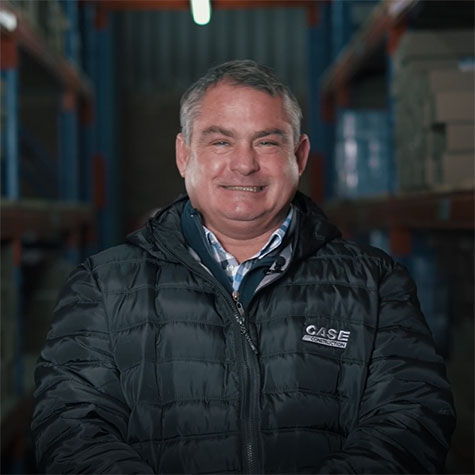
CASE offering
To ensure that quarries meet their production targets, CASE loaders are designed with a strong focus on efficiency, reliability and comfort, with several features that speak to these important parameters. Key among them is the engine, which was developed and manufactured by CASE’s award-winning sister company, FPT Industrial, which produces over 500 000 engines per year and powers world record winners.
“The in-house design leverages advanced technologies developed for commercial vehicles and agriculture, and introduces specific tailored solutions for off-road applications,” says Alexander. “Our engine technology is so reliable that it is trusted by the French Sea Rescue service for their boats: what better guarantee could you wish for?”
CASE’s 1021F wheel loader’s 8,7-litre cursor engine ensures better engine control at all runs per minute. The multiple injection technology ensures optimum combustion control, while the 1 600-bar injection delivers best-in-class torque performance. The combustion is optimised for maximum efficiency, at high temperatures using 100% fresh, cool air, as the air intake is separated from the exhaust. The turbocharged engine with an air-to-air intercooler relies on a three-step injection technology to maximise responsiveness and fuel efficiency with reduced engine noise and vibrations.
With reliability in mind, the heavy-duty axles of the CASE wheel loader are tough, big and easy to service thanks to the three-piece housing design. Wet multiple disc brakes are located in each wheel hub. The heavy-duty axles are engineered to support L5 or solid tyres for very abrasive environments. Solid tyres can be factory-fitted.
The axle differential locks reduce tyre spin and provide 20-30% lower tyre wear, improving tractional force and bucket penetration, reducing loading cycle times and improving fuel efficiency and tonnes per hour.
The unique design of the CASE cooling cube, with five radiators mounted to form a cube instead of overlapping, ensures a constant flow of fresh and clean air from the sides and from the top, to maintain constant fluid temperatures. The cube structure provides easy access to radiators for a more effective cleaning and serviceability; additional cleaning can also be easily done manually, with separate access to each radiator.
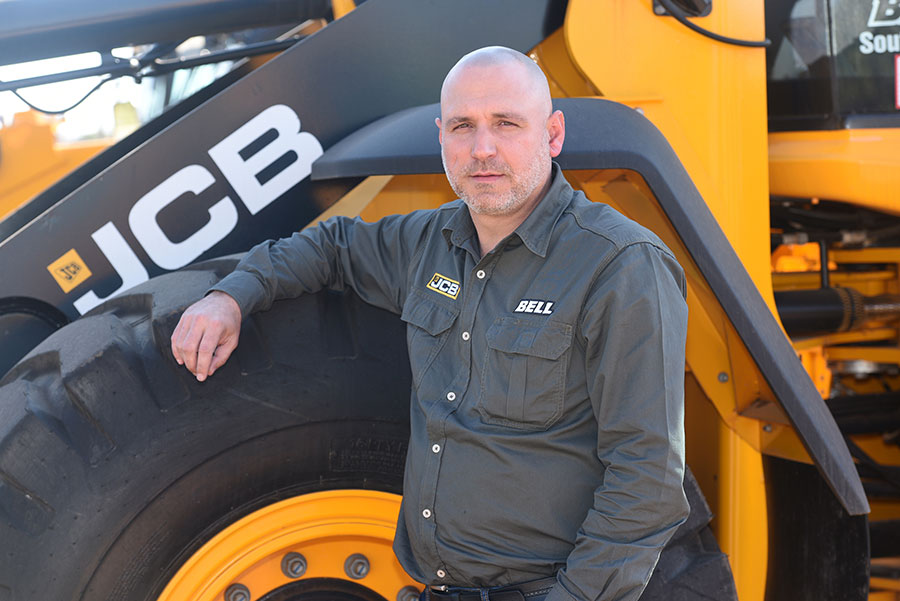
Bell’s offering
Bell Equipment has three JCB wheel loaders in its range that are ideally suited to quarrying applications, namely the 15-t JCB 436ZX, the 18-t JCB 455ZX and the 24-t JCB 467 ZX, all of which have high power-to-weight ratios for class-leading climbing and stockpiling capability. The Z-bar loader design supports productivity by providing great penetration into the pile, high breakout forces, good rollback angles and faster digging times.
The JCB 467 ZX has a smooth ride suspension system that reduces material spillage and structural stresses while delivering superior operator comfort.
“The three models all have ergonomic ROPS/FOPS-certified cabs with air conditioning for comfort and joystick controls for ease of operation. All come standard with JCB’s LiveLink telematics solution, which monitors machine hours, fuel consumption, servicing intervals and fault codes, among other parameters, from a laptop or mobile device,” says Du Toit.
Various buckets are available, including options suitable for high SG and abrasive materials. Bell also retrofits strobe lights, fire extinguishers and stop blocks on its JCB wheel loaders as required.
The Widecore cooling pack keeps the machine operating at an optimum temperature by allowing large debris to pass through, while the reversible fans are ideal for working in dusty quarry environments. In addition, ground-level servicing promotes ease of maintenance.
JCB wheel loaders carry a 12-month/unlimited hours warranty and finance options are available through JCB Finance.
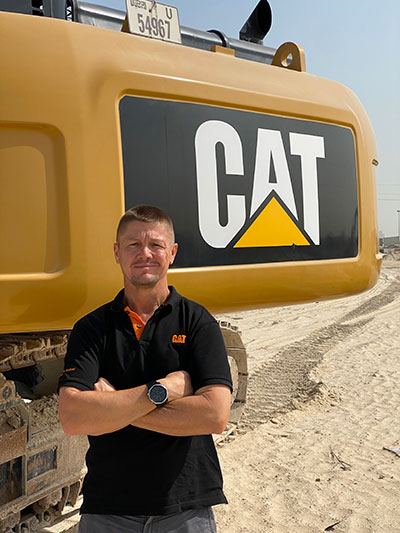
Cat offering
Caterpillar’s medium wheel loader offering ranges from the Cat 950 to the Cat 982. The ease-of-use features integrated on the next generation platform improve performance and efficiency for expert or non-expert operators.
Cat Large wheel loaders (986K to 995) set the standard for optimised productivity, minimising downtime, enhancing operator comfort and protecting people on jobsites through key safety.
The large Cat wheel loaders come with Operator Coaching so operators can be trained on the go or as required, without the intervention of a trainer, so increasing efficiencies on the go or when needed.
Large Cat wheel loaders also include assist features that partially take the control of the complex operations during the dig phase (Rimpull modulation, lift command) and help close the gap between new and experienced operators and help increase the efficiency levels for all.
All Cat Performance series medium wheel loaders today come with a factory installed payload system fitted as standard to help increase loading accuracy. Our Standard models have the option to have a similar Cat payload system fitted at the Cat dealership, giving the same capabilities. For the larger wheel loaders, a factory payload system is also available.
